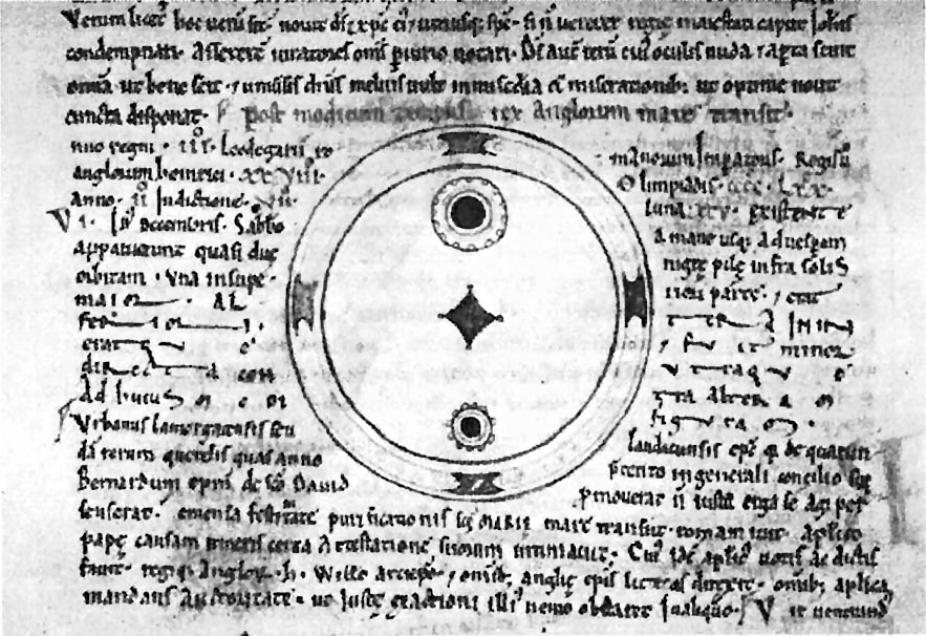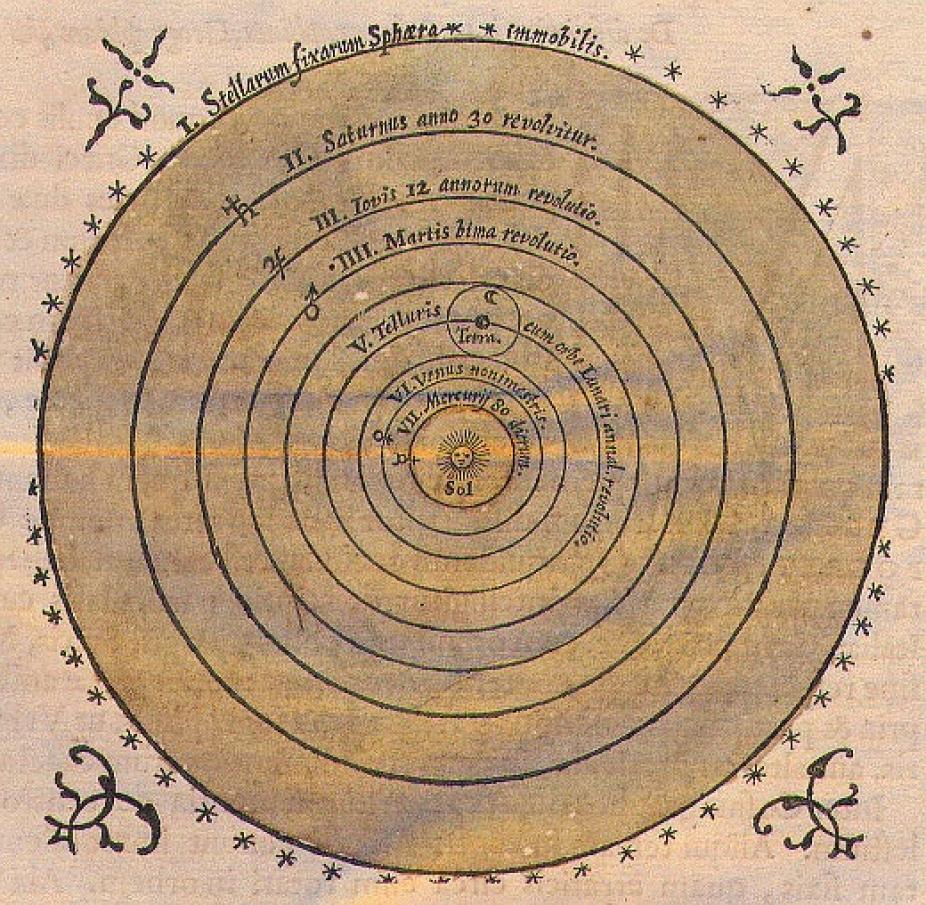Solar Physics Historical Timeline (0 - 1599)
Timeline
In this page
AD 968: The first mention of the solar corona

The first mention of the solar corona was by Leo Diaconus in 968 AD.
The solar corona is the hot, extended outer atmosphere of the Sun. It is far too faint to be seen against the blinding brightness of the solar disk itself, but becomes visible, and spectacularly so, at times of total solar eclipses when the solar disk is obscured by the Moon.
While the solar corona is visible at any total solar eclipse, the first explicit mention of what can be unambiguously interpreted to be the corona was made by the Byzantine historian Leo Diaconus (ca. 950-994), as he observed the total eclipse of 22 December 968 from Constantinople (now Istanbul, Turkey). His observation is preserved in the Annales Sangallenses, and reads:
"...at the fourth hour of the day ... darkness covered the earth and all the brightest stars shone forth. And is was possible to see the disk of the Sun, dull and unlit, and a dim and feeble glow like a narrow band shining in a circle around the edge of the disk".
Compare this description to the modern eclipse photographs shown on slide 9 and slide 10 of the HAO Sun Pictorial. A much older possible description of the corona is said to be found on engraved oracle bones dating from the Shang dynasty in China (1766 to 1123 BC), but is far more ambiguous and open to interpretation than Diaconus' description.
References and further reading
- Hetherington, B. 1996, A chronicle of pre-telescopic astronomy, John Wiley and Sons.
1128: The first sunspot drawing

Sunspot drawing in the Chronicles of John of Worcester, twelfth century. Notice the depiction of the penumbra around each spot.
R.W. Southern, Medieval Humanism, Harper & Row 1970, [Plate VII]
This drawing, from the Chronicles of John of Worcester (one of the many monks who contributed to the Worcester Chronicles), represents to the best of our knowledge the first surviving sunspot drawing, from a sighting on Saturday, 8 December 1128. Compare it with the sunspots seen on Slide 1 and Slide 3 of the HAO Sun Pictorial.
The accompanying text translates to something like:
"...from morning to evening, appeared something like two black circles within the disk of the Sun, the one in the upper part being bigger, the other in the lower part smaller. As shown on the drawing."
The facts that the Worcester monks could apparently distinguish the umbrae and penumbrae of the sunspots they observed suggests that the spots must have been truly exceptionally large.
Large sunspots can be visible to the naked-eye under suitable viewing conditions, for example when the sun is partially obscured by clouds or mist, particularly at sunrise or sunset. Numerous such sightings exist in the historical records, starting with Theophrastus (374–287 B.C.) in the fourth century B.C. However, the most extensive pre-telescopic records are found in the Far East, especially in the official records of the Chinese imperial courts, starting in 165 B.C. In the West, the dominating views of Aristotle (concerning the incorruptibility of the heavens) meant that sunspots were "physically impossible", so that sightings were ignored or ascribed to transit of Mercury or Venus across the solar disk.
References and further reading
- Van Helden, A. 1996, Galileo and Scheiner on sunspots, in Proc. Am. Phil. Soc., 140, 358–396.
1185: The first description of solar prominences
Prominences are large accumulations of (relatively) cooler gas held suspended high in the solar atmosphere by the Sun's magnetic field (see Slide 6 and Slide 7 of the HAO Sun Pictorial). Large prominences are often visible during total solar eclipses, in the form of small reddish filaments or blobs in the lower corona. A description of what can be possibly interpreted as prominences can be found in Chinese court records dating from 28 BC by Chinese astronomers during the reign of Emperor Cheng of the Western Han Dynasty. From then until the late Ming Dynasty in the mid-17th century, Chinese history books recorded more than 100 sunspots. Furthermore, they also took note of other phenomena concerning the sun, such as solar prominences and coronas. The first record of a solar prominence has been found in a tortoise shell inscription, which describes "three suddenly bursting fires eating a chunk of the sun". The first unambiguous description of prominences is usually taken to be that found in the Russian Chronicle of Novgorod, in the following description of the 1 May 1185 solar eclipse:
"In the evening there was an eclipse of the sun. It was getting very gloomy and stars were seen ... The sun became similar in appearance to the moon and from its horns came out somewhat like live embers."
References and further reading
- Sviatsky, D. 1923, Astronomy in the Russian Chronicles, Journal of the British Astronomical Association, 33, 285–287.
- Hetherington, B. 1996, A chronicle of pre-telescopic astronomy, John Wiley and Sons.
1543: The Sun moves to center stage

The Copernican planetary model. The Sun is at the center of all planetary motions, except for the Moon which orbits Earth. Under this arrangement the orbital speed of planets decreases steadily outwards, and the outer sphere of fixed stars is truly motionless. In Copernicus' original model the Earth has three motions: a daily 24-hr axial rotation, a yearly orbital motion about the Sun, and a third motion, somewhat related to procession which Copernicus thought necessary to properly reproduce ancient observations.
The cosmos of the late Christian medieval era was a fusion of ideas combining the physics of Aristotle with the planetary astronomy of Ptolemy. This is the world view that was destroyed in the sixteenth and seventeenth centuries. The first blow was dealt by Nicholas Copernicus (1473–1543), who published his landmark book "De Revolutionibus Orbium Coelestium" in 1543. There, Copernicus presented a new planetary model with the Sun placed in center, and letting all planets (including the Earth) orbit around the Sun. Copernicus also gave the Earth two additional motions: a daily axial rotation, and a procession of that spin axis. In doing so, Copernicus eliminated the need for the two outermost spheres of the ptolemaic model and produced a system where the speeds of revolution decrease gradually outward all the way to the fixed stars.
Copernicus ostensibly introduced his heliocentric model in order to do away with equants and various motions previously attributed to the sphere of fixed stars, but it appears clear that he believed in the physical reality of his heliocentric hypothesis. Because Copernicus' model could be construed as yet another mathematical device useful in astronomy, but without physical reality, his model could be used by astronomers without attracting the ire of philosophers and theologians committed to the centrality and fixity of the Earth. This situation was to change in the next century.
References and further reading
- Kuhn, T.S. 1957, The Copernican Revolution, Harvard University Press.
- Boas, M. 1962, The Scientific Renaissance 1450–1630, Harper & Row [Dover reprint available].
- Gingerich, O. 1993, The Eye of Heaven, New York: American Institute of Physics.
- Grant, E. 1994, Planets, Stars, & Orbs. The Medieval Cosmos, 1200–1687, Cambridge University Press